Kimono Flea Market ICHIROYA's News Letter No.452
Hello from Japan! This is Kimono Flea Market ICHIROYA's News Letter No.452.
I have introduced the methods how to tell the material of kimono fabric. before.
I tried to find the definitive edition of the methods but could not find through research, so I decided to write this article which can be a good reference to be used for a long time. I hope this article can be useful!
To begin with, what is fiber and how they are made. The terms are quite confusing in Japanese, maybe that is the same in English or other language also..
Silk can be described as Shoken(genuine silk) or kinu(silk) but they are both silk.
Gosen and Koshoku---they are confusing, go means to mix, ko means to cross or join.
Gosen is artificial(synthetic) fiber and Koshoku is woven by multiple different material, such as silk and rayon together. Koshoku usually refers two different materials which are natural and artificial.
When we discuss what makes fiber, we need to know what makes the thread.
Thread is made of protein, cellulose or petroleum oil. If you know this, it is very easy!
What fiber is made from protein? Silk and wool of course! We must thank silkworms and sheep!
If you burn protein, what will happen? Just imagine a scene of explosion from comedies. Face becomes black and hair becomes fuzzy. That is how silk burns. It burns and extiguiqsh naturally and the ash is like black powder.
Here is the video of burning test of silk:
Just one thing should be added---silk with black dye often burns differently because of the black dye stuff.
Now when you burn wool, it looks like they look very similay to silk but smell is so different.
Wool smells so bad when it is burnt, so you can tell by the smell.
You can also tell the which one is wool by the texture. Wool has this slightly stinging texture, so you can touch carefully or try to check the feel by your cheeks. If the fabric has this stinging texture, it can be wool.
Silk, cotton and wool are made by short fiber but wool is the only one you feel this stinging texture.
Everything which are plants origin are cellulose, so cotton, asa(ramie) and jinken(rayon) are all in this group. When they are burnt, they keep burning to become ash.
Then what is the method to tell which is which? Cotton and asa(ramie) are made from short fiber but jinkn(it is made to be an alternative of silk) usually have long fiber. Cotton and asa(ramie) , they are alike but asa(ramie) tend to be smoother while cotton is more textured. Jinken is made from pulp, so you can consider jinken as paper(even though some jinken are so similar to silk and hard to tell the difference). When we see jinken by scope, they look so smooth and so even(and look artificial). You can just remember, these fabrics burn like a piece of paper.
So what you can do is to guess the fiber by its texture first- then do the burn test(if it is possible) and also check with microscope.
If burn text does not go well, then you can try to burn warp and weft separately.
By doing above experiment, you can tell most fabrics.
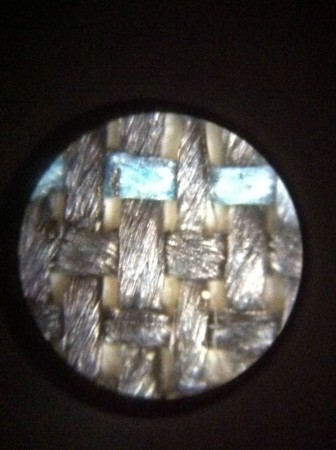
Noto jofu(asa) 50x
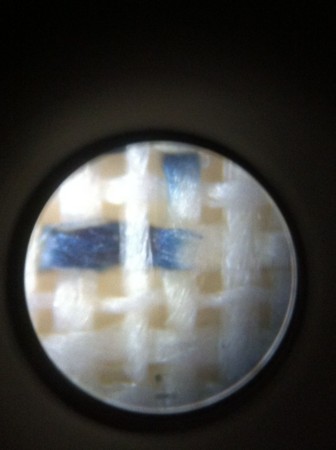
Ohmi jofu (asa) x50
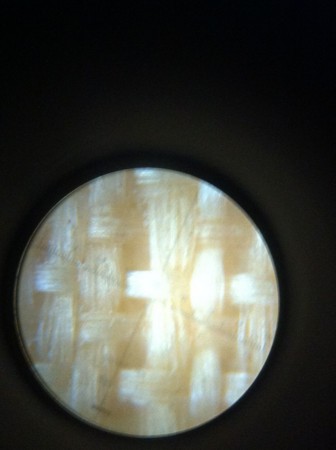
Nara sarashi (asa)x50
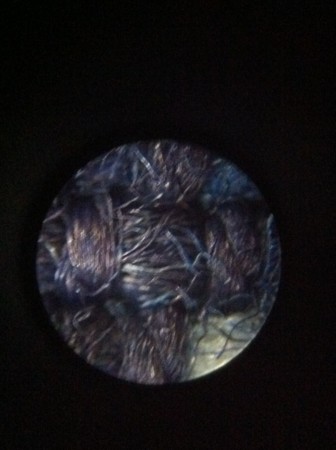
Yumhama kasuri (cotton) x50
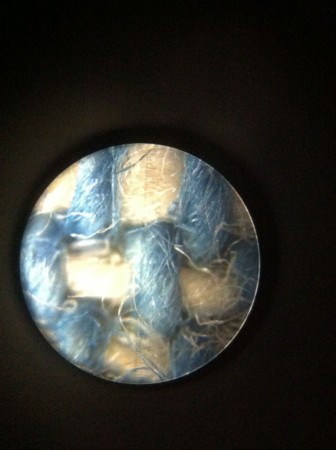
Mashiko momen(cotton) 50x

Bingo kasuri (cotton) 50X
The first three are asa(ramie) and next three are cotton.
I hope you can tell the difference of smoothness and textured surface.
However the case like the following photo is very confusing.
This is Yaeyama koufu and warp is cotton and weft is asa (ramie), actually.
It is hard to tell the difference even through the scope.
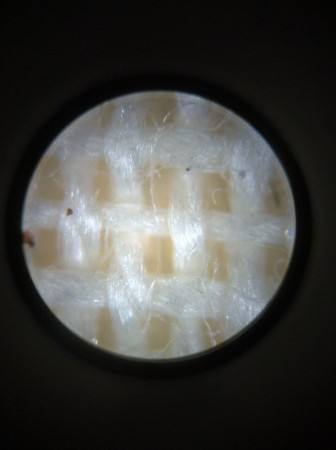
Here is an example of jinken(rayon- long fiber)
This is from antique ro kimono.

Jinken(rayon) 50X
I am sure you can see this very smooth and even threads.
Without scope also, it is easy to tell.
However, ther are fabrics like Yaeyama kofu(warp and weft are different). Also cottn woven with very thin thread are sometimes seen also. After all, the difference among asa(ramie) , cotton and jinken needs to be judged by comprehensive anaylysis using checkng the texture, touch, using scope and so on.
Finally, fabrics made of petroleum oil-polyester is known as a representative.Vinylon and acrylic are the same group too and they are just like pet bottle or plastic. When they are burnt, the melted part becomes hard.
Very well made polyester can deceive professional kimono dealers with a long career, but once it is burnt, it is obvious.
There are two other synthetic fiber used for kimono, they are not seen so often but they are acetate, and promix.
Acetate are often used for old children's kimono. They have gloss like silk. They are made of pulp and acetic acid, so we can often smell like vinegar.
Promix are called Gyunyu(milk) in kimono field. They are actually made from protain of milk and acrylic. The fabric has crisp and smooth texture just like Oshima but by burning test, you can tell the difference easily.
If you know all three composition(protein, cellulose and petroleum oil, then it will be easy to tell the difference of fabrics.
Here is one left-Bashofu(banana leaf fabric), very crisp touch!

We will be adding charming new arrivals also, we hope you enjoy checking our new arrivals too.
domo argato gozaimasu
with many kansha,
Ichiro & Yuka Wada
Kimono Flea Market ICHIROYA
http://www.ichiroya.com
e-mail: info@ichiroya.com
address: Asia-shoji Bldg.301
1841-1 Nishi 1 chome
Wakamatsu cho
Tondabayashi city
Osaka 584-0025 JAPAN
TEL&FAX ( international number ) -
人気ブログへの道(90日間連続投稿やってみた)
人気ブログへの道は遠い。
というか、この道が人気ブログへの道に通じているのか、わからないままに、とにかく、90日連続で投稿してきた。
何回も何回も読み返した記事。
*ブログを毎月30万PVにするために僕が行なっている15の戦略
*これからブログを頑張ろうと思う人へ。まずは三ヶ月毎日書く。話はそれからだ。
おふたりとも、とにかく90日毎日更新せよ、と説かれている。
90日連続投稿したら、なにが起きるのか。
今日は、その結果報告である。(正確には88日目、90投稿)
(1)目標達成できず
一応、90日目の目標を設定していた。
*ユニークユーザー 500/1日
*ページビュー 1000/1日
である。
結果は、おおよそ
*ユニークユーザー 250/1日
*ページビュー 350/1日
であった。
目標の半分。
かなり、恥ずかしい結果である。
(2)覚悟を決めれば、毎日記事を書くことはできる
当初、このブログを始めたとき、毎日更新することなどできるのか、と思っていた。
でも、「毎日更新します」と宣言してしまったので、とにかく、必死で、毎日文章を書いた。
毎日書いて、自分の経験のネタがなくなってしまってからが、勝負。
ネタは頭から絞り出せ、と上述のブログに書いてあったのだた、たしかにそのとおりかと思う。
書くことがないと、切羽詰まっても、ぎりぎりのところで、なんとかなるものだ、といまは思っている。
しかし、毎日、毎日、自分の恥や失敗をさらけ出してきたので、ときどき、街を歩いていて、思い出して赤面する。
とくに、めちゃくちゃ恥ずかしい、真剣にかっこ悪いと思うこと、できたら記事にしたくない、というようなことほど、記事に書くと好評である。
で、そんなことも、書いてしまうので、ときどき、あまりの恥ずかしさに、どこかに小さく丸くなって隠れていたいとの衝動にかられる。
(3)記事は、量か質か
毎日更新したからといって、人気ブログになるわけでは、全然ない。
反対に、1週間に1~2本の、エッセンスの濃い、とにかく、役に立つ記事を書いたほうが良い、という声もある。
まあ、しかし、はっきりしているのは、量と質、両方を追わなければ、人気ブログにはなれないってことだと思う。
たとえば、このブログも、検索からの流入が増えてきた。
検索ワードでは、「怖い話、実話」がダントツに多い。
そのほか、「ニュージーランドの育毛剤」とかもあって、検索で来ていただいたかたには、読んでみたら、おちゃらけで、まことに悪印象であるかと思う。
これではいかん、たまにはまじめに役に立つ記事を書いてみようと思って、昨日
着物の生地の見分け方(ICHIROYA流:決定版)
を書いてみた。
Googleはさすがで、書いて2,3時間後には、「着物 生地 見分け方」で検索すると1ページ目8位に出てきた。
もし、この記事の需要が高ければ、検索から多くのひとが見に来てくれることになる。
実際のところ、記事のニーズは限られているので、さほど来訪者が増えるとは思えないのだけど、もし、それがAppleの役立つ使い方に関する記事だったりすれば、たくさんのかたが見に来るだろうと思う。
そして、そういった記事が300も400もあれば、相当なPVになることは、間違いないと思う。
しかし、一番の問題は、そういったお役立ち系の記事は、あんまり書けそうにないってことだ。
(4)やってみて良かったこと
ブログは長い名刺のようなものだ、と言われる。
たしかに、そういう面があり、たとえ、「人気ブログ」になれなくても、やる価値は大いにある、といまでは思っている。
フェイスブック、Twitterもやっているのだけど、ブログを書くことで、たくさんのかたとお知り合いになることができた。
フェイスブック、Twitterだけのつながりというのは、どうしても相手のことを知るにも限界があるのだけど、それにブログがつながると、自分がどういう人間であるのか、より深く知っていただける。
こちらも、相手のかたがブログを書いていると、どういったかたかよくわかり、現実の知人よりずっと深いお付き合いのような気がする。
そういえば、このブログを始めてから、「着物を買い取って欲しいんだけど」という電話をいただくことが増えた。
着物をどこよりも安く買取ります!
などと書いている古着屋は日本広しといえども、僕だけだろうけど、いつもホンネを書いているので、「ブログを読んで信頼できそうな気がして」と言ってもらえるのだと思う。
(5)当分がんばってみます
当初書き始めたとき、「才能があれば、すぐに人気ブログになるだろうし、90日も続ければ、はっきりわかるだろう」と思っていた。
たしかに、「90日で人気ブログにするほどの才能はない」ことはわかった。
相当恥ずかしい。
何がしたいかといえば、「便利ネタを丁寧に書いて役に立つサイトにする」という方向ではなく、「とことん着物のことを書きたい」わけでもない。
やっぱり、自分が書いているのは、
ひとりでも多くのひとと、共感したい。
ちょっと、くすっと、笑って、和んで欲しい。
という理由からなのだ。
その先に、もう少し、社会的な主張をしていきたい、ってこともあるんだけど、いまは、自分が納得できる、「一般的な事象について、オリジナルな感性に基づく、オリジナルな主張」をする自信がない。
なので、当分は、「個人的な事象について」、自分の感じることを、自分がおもしろいと思う方法で書いていきたいと思っている。
人気の「Chikirinさんの日記」は、2005年開設であった。毎日更新ではないけど、すでに8年目である。
僕も、もうしばらく、がんばってみようと思う。
で、内容も、いろいろと、楽しいことが書けるよう、工夫していきたい。
ということで、ここまで読んで下さった、あなたさま!
わざわざ短くもない僕の文章を読むのに、貴重な時間をさいていただき、ほんとうにありがとうございます!
今後もよろしくお願いします。
ブログを書いておられる方なら、いっしょにがんばりましょう!
追記:106日目の後日談:「人気ブログへの道(3) ひと筋の光明が見えた!」も合わせてお読みください。
